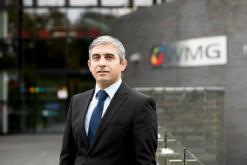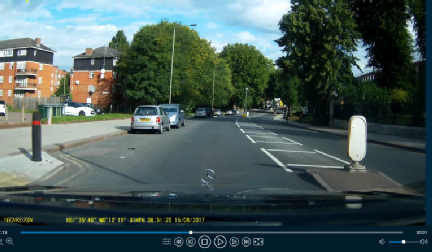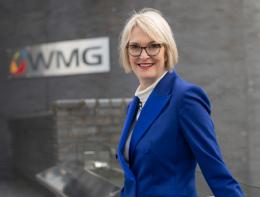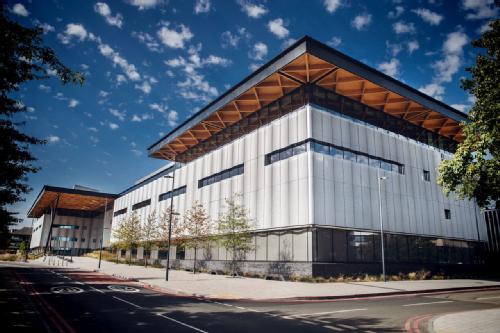WMG News
WMG Professor takes up key editorial role at international journal
 Congratulations to WMG Professor of Connected and Automated Mobility Systems, Mehrdad Dianati, who has been appointed as Field Chief Editor for Frontiers in Future Transportation journal.
Congratulations to WMG Professor of Connected and Automated Mobility Systems, Mehrdad Dianati, who has been appointed as Field Chief Editor for Frontiers in Future Transportation journal.
As an esteemed expert within autonomous vehicle research, Professor Dianati was appointed to define the overall scope and reputation of the journal, and provide key support and guidance to the editorial board.
As Field Chief Editor, he will also be tasked with creating a community of future transportation researchers and ensure their work is fully represented in key publications.
Commenting on his new role, Professor Dianati said: “As the transport systems become more complex and multifaceted cyber-physical systems, multi-disciplinary and innovative approaches to dissemination of the scientific and technological innovations are crucial to transform the ways that scientists impact the society.
“Frontiers in Future Transportation focuses on providing a state-of-the-art open access platform to maximize the impacts of the cutting-edge scientific and technological innovations that will transform the future of transport and mobility systems. Our ambition is to facilitate a timely, constructively selective and high-caliber peer review process through our distinguished multi-disciplinary and international editorial board to ensure high-quality publications with a wide reach and impact.”
Find out more about Professor Dianati’s research at WMG here.
The WMG Battery School is back, and it’s virtual!
 The WMG Battery School, supported by the APC and HVM Catapult, will take place, from 14th to 18th September, for key industry personnel.
The WMG Battery School, supported by the APC and HVM Catapult, will take place, from 14th to 18th September, for key industry personnel.
WMG battery experts will facilitate a mix of live lectures and pre-recorded practical hands-on-sessions, virtually, over the five days.
The lectures will cover manufacturing Lithium batteries, module and pack design, electrical testing and ageing, battery management systems, safety and abuse testing, forensic characterisation and battery end of life.
Meanwhile the practical, pre-recorded in the Energy Innovation Centre, lab sessions, will focus on microscopy; electrode mixing and coating; pouch and cylindrical cell fabrication; cell and module testing; and forensics.
Find the full lecture and demo programme and register your interest here or by email: WMGShortCourses@warwick.ac.uk
WMG supports the new West Midlands India Partnership
WMG, at the University of Warwick, are delighted to be supporting a new West Midlands India Partnership (WMIP), which aims to enhance UK-India relations and boost tourism, trade and investment between the West Midlands and India.
 The Partnership, which launched on 26th June 2020, will support the region’s long-term economic growth plans by developing stronger links and opportunities for collaboration as part of a five-year programme of activity with the Indian market.
The Partnership, which launched on 26th June 2020, will support the region’s long-term economic growth plans by developing stronger links and opportunities for collaboration as part of a five-year programme of activity with the Indian market.
Led by the West Midlands Growth Company, this new initiative has been developed in partnership with Invest India, the Confederation of Indian Industry and the Consulate General of Birmingham office.
Margot James, Executive Chair, WMG took part in the launch and comments:
“WMG and the late Professor Lord Bhattacharyya were instrumental in many large-scale inward investments, nurturing UK and India partnerships, such as the acquisition of Jaguar Land Rover by Tata, from which the West Midlands has benefited hugely. Our region has a strong heritage, close cultural links, and great business collaboration with India, but it is important to look to the future.
I welcome the new West Midlands India Partnership. The key word is partnership. We must recognise that both parties have something valuable to bring to the collaboration. Both the West Midlands and India have strengths to offer the other, and we need to build connections to create awareness of those strengths.
The West Midlands has incredible research strength, and a powerful capability through clusters of excellence in engineering, manufacturing and digital technology. India has a superb research and technical capability, for example the Indian Institutes of Technology and the Indian Institutes of Management. These assets work alongside innovative, forward thinking businesses including Tata, TVS, Wipro, Infosys and Mahindra.
I am delighted that WMG will continue to help build a strong West Midlands-India relationship, alongside the Mayor's office, the Indian Consulate and the West Midlands growth Company. When we work together, we all benefit.”
The WMIP will be governed by two separate boards comprised of senior stakeholders, leaders and representatives. The Advisory Board, of which WMG is a member, will be responsible for the strategic direction of the Partnership, providing advice and guidance to the Executive Board, which will shape the planning and delivery of the programme’s activity.
Dr. Jason Wouhra OBE, Chair of the West Midlands India Partnership, said:
”The West Midlands India Partnership is a confident step forward at a time when building resilient, productive economies is key. Through the Partnership’s long-term strategy, we aim to identify opportunities for both Indian and local businesses to trade, innovate and grow."
Neil Rami, Chief Executive of the West Midlands Growth Company – which aims to attract investment, jobs and visitors to the region, added:
“The region already has a strong track record of organic success derived from the Indian market. Launching the West Midlands’ first formal India Partnership will unlock even greater opportunities for growth across trade, education and the visitor economy. It presents a major opportunity for both the UK and India to advance our national missions.”
Lakshmi Kaul, Head & Representative – UK at Confederation of Indian Industry, added:
“The West Midlands is a melting pot of cultures, diversity and business excellence - the region is important for Indian industry as a hub of innovation and research. Confederation of Indian Industry (CII) is pleased to support the West Midlands by working alongside the Partnership to amplify business-to-business, as well as the people-to-people connection, while also addressing the economic growth and recovery roadmap.”
Andy Street, Mayor of the West Midlands, added:
“The West Midlands’ innovation-led Industrial Strategy alongside the scale and ambition of India’s manufacturing, life sciences and technology sectors presents a major opportunity for world-class industry collaboration, helping to attract significant investment and create new, local jobs.
“The West Midlands India Partnership will bring together some of the best talent and capabilities to not only stimulate cross-market trade, but to help address shared social and economic challenges faced by the UK and India. I am delighted we have been able to secure this Partnership, which represents a further strengthening of the already excellent ties between our region and India.”
To find out more about the West Midlands India Partnership or to sign up as a partner, please visit https://wmgrowth.com/wmip
View the launch hereLink opens in a new window
The early pandemic paradox: fewer deaths in the first 4 months of 2020 compared to the previous 5 years
- Scientists at the Institute of Digital Healthcare, WMG and Warwick Medical School, at the University of Warwick, have analysed mortality statistics in the UK during the initial phases of the severe acute respiratory coronavirus 2 (SARS-CoV-2) pandemic, by analysing the weekly national mortality statistics over the last five years including the subgroup of respiratory mortality rates
- They found there were fewer deaths recorded from the end of December 2019 until the end of March 2020 in comparison to the previous five years, including in the subgroup assessment of respiratory mortality rates
- The researchers describe a SARS-CoV-2 Paradox that resulted in a lower death rate during the early stages of the pandemic in comparison to previous years, perhaps due to government enforced social distancing introduced in the middle of March.
- Some had already engaged with social distancing before a formal lockdown, and precautions such as more hand washing, lead to a reduction in the mixing of those with infectious diseases including, but not exclusive of, SARS-CoV-2
An analysis of national weekly mortality rates between December 2019 – March 2020, compared to the same period for the previous five years, by researchers at WMG and WMS, University of Warwick, has shown that there have been fewer deaths registered this year during the lead up to the Covid-19 pandemic. Researchers have called this the SARS-CoV-2 Paradox - which could be due to early social distancing measures.
Researchers from the Institute of Digital Healthcare, WMG and Warwick Medical School, at the University of Warwick, have analysed the mortality statistics in the United Kingdom during the initial phases of the severe acute respiratory coronavirus 2 (SARS-CoV-2) pandemic to understand the impact of the pandemic on national mortality figures.
They did this by carrying out a retrospective review of weekly national mortality statistics in the United Kingdom over the previous 5 years, including subgroup assessment of respiratory mortality rates, from the end of November until the end of March.
The analysis found that during the first months of 2020, when the early phases of the severe acute respiratory coronavirus 2 (SARS-CoV-2) pandemic was apparent in the UK, there were consistently fewer deaths each week compared with the previous five years.
However, such a pattern has not been seen in the previous five years of data, researchers coined this the SARS-CoV-2 Paradox, and propose the reason why the death rate was lower during the early stages of the pandemic in comparison to previous years could be due to social distancing, as whilst the government enforced social distancing in the middle of March, some had already engaged with this, especially higher risk groups/elderly, leading to a reduction in the mixing of those with infectious diseases including, but not exclusive of, SARS-CoV-2.
It could also be due to the emphasised importance of washing hands, staying home when you feel unwell and coughing or sneezing into a tissue, this is likely to reduce the number of cases of other infectious disease and, also, slow the spread of various infectious diseases. Finally, iatrogenic mortality may be reduced, as hospital admission numbers have reduced; and there may thus be a reduction in the spread of hospital-acquired infections, such as methicillin-resistant staphylococcus aureus (MRSA). Similarly, reductions in elective surgery (in order to prepare intensive care and hospital bed capacity) may result in fewer iatrogenic deaths.
The graph shows week 12, the 20th March there was an increase in deaths, with 2020 deaths being 10,645, and previous 5 year mean to be 10,573, this could be related to covid-19, as symptoms such as headaches and loss of taste weren’t identified, however it could also be attributed to closed GPs, an overwhelmed A&E and ITUs being increasingly selective about which patients to take as lockdown was formally announced that week.
Professor Theo Arvanitis, from the Institute of Digital Healthcare at WMG, University of Warwick comments:
“Each year, infectious diseases make a significant contribution towards avoidable deaths in England and Wales. People with multi-morbidities are at particular risk, and this is a key area of research for the Institute of Digital Healthcare. Social distancing measures are likely to impact the spread of all infectious diseases, despite their target being a reduction in the spread of SARS-CoV-2 virus. This lack of disease spread could be causing a reduction in death rate. Another factor could be concerns around the virus, which could mean people are making more conscious health decisions in terms of eating, exercise, reducing smoking and resting, when they feel unwell, or seeking advice from 111 about their symptoms.
“It is important to note that whilst we have seen a reduction in mortality in the ‘run-up’ to seeing the full extent of SARS-CoV-2 that this may also have negative future consequences. It is possible that we may see a significant rebound if this mortality has simply been delayed rather than avoided in its entirety. If a rebound affect is seen, this may coincide with the peak demand for SARS-CoV-2 medical beds, creating an even greater healthcare need.
“Overall, this stresses the need for careful ongoing observation and exploration of these mortality trends. This assessment must take account not just of the SARS-CoV-2 peak, but also the time period prior to, and following the pandemic.”
- ‘England and Wales Mortality Statistics: The SARS-CoV-2 Paradox’ is published in the Journal of International Medical Research, DOI: 10.1177/0300060520931298
ENDS
22 June 2020
NOTES TO EDITORS
High-res images available at:
https://warwick.ac.uk/services/communications/medialibrary/images/april2020/theoarvanitis.jpg
Caption: Professor Theo Arvanitis, Institute of Digital Healthcare, WMG, University of Warwick
https://warwick.ac.uk/services/communications/medialibrary/images/june2020/table_1.jpg
Caption: Deaths rates in England and Wales: comparing deaths between December 2019 and March 2020 to death rates over the same period in the previous 5 years.
https://warwick.ac.uk/services/communications/medialibrary/images/june2020/figure_2.jpg
Caption: Possible mechanisms for reducing all-cause mortality.
For Press enquires please contact:
Peter Thorley, Media Relations Manager (Warwick Medical School), Peter.Thorley@warwick.ac.uk, 07824 540863
OR
Lisa Harding, Head of Marketing and Communications (WMG), Lisa.Harding@warwick.ac.uk, 07824 540845
UK Government switching model for contact-tracing app – expert comment from Professor Carsten Maple
 The UK Government has announced that it will switch its contact-tracing app to a model based on technology by Apple and Google. Professor Carsten Maple, of WMG at the University of Warwick, discusses the impact that this might make to public confidence in the app.
The UK Government has announced that it will switch its contact-tracing app to a model based on technology by Apple and Google. Professor Carsten Maple, of WMG at the University of Warwick, discusses the impact that this might make to public confidence in the app.
Professor Maple is Professor of Cyber Systems Engineering and recently led research that showed that the UK public wants the NHS to be the controlling body in the Covid-19 contact-tracing app.
Professor Maple said: “The Government changing their stance on the architecture is a significant development. It is worrying that the Government feel they cannot create an app which could, by its own assessment, have a significant impact on controlling the pandemic, without relying on the support of the major tech companies. We should recall that the early versions of apps in other countries could not avail themselves of this Apple and Google capability, but were still effective in controlling the virus. It will be interesting to see how the Government will now attempt to gather the data that they said was so important to control the pandemic, and worth the privacy intrusions that arose in their abandoned version, now that they are taking this new route. This, in itself, could erode confidence in any app that is released."
How dashcams help and hinder forensics
 Dashcams are vital for helping police investigate car incidents, however the way the footage is submitted to police, managed and processed can cause problems. A researcher at WMG, University of Warwick has assessed seven different types of dashcams’ SD storage systems to see how they help and hinder digital forensics.
Dashcams are vital for helping police investigate car incidents, however the way the footage is submitted to police, managed and processed can cause problems. A researcher at WMG, University of Warwick has assessed seven different types of dashcams’ SD storage systems to see how they help and hinder digital forensics.
Many cars now have dashcams, an in-vehicle mountable camera which records video and audio footage of journeys. They have significant evidential value in digital forensics as they provide GPS data, temporal data, vehicular speed data, audio, video and photographic images.
In the paper, ‘Dashcam forensic: A preliminary analysis of 7 dashcam devices’, published in the paper Forensic Science International: Digital Investigation, Dr Harjinder Lallie, from WMG, University of Warwick explores two aspects of dashcam evidence: the problems related to the management and processing of dashcam evidence, and an analysis of artefacts generated by dashcams.
WMG celebrates #1OfTheMillion Day
WMG is proud to be supporting the WISE #1OfTheMillion Day (Wednesday 10th June).
The WISE campaign celebrates the one million women who are now working in core STEM roles across the UK.
 WMG’s Executive Chair Margot James commented: “ We need a positive plan to tackle the under-representation of women, people of colour and all minorities in our sectors. Industry needs a boosted pipeline of under-represented groups to feed the growing number of STEM roles.
WMG’s Executive Chair Margot James commented: “ We need a positive plan to tackle the under-representation of women, people of colour and all minorities in our sectors. Industry needs a boosted pipeline of under-represented groups to feed the growing number of STEM roles.
“ During my time in government we analysed how behavioural insights might help us understand the career choices for young women, and women entering the workforce, in making decisions that’s leading them away from STEM subjects in school and from tech careers.
“ A diverse workforce, at all levels in an organisation, can improve a company’s bottom line and they are more likely to outperform their competitors financially. So, I am delighted that there are now one million women leading the way in STEM careers which is so essential for the continued success of our economy.”
Read more about the women working in STEM at WMG here.
New study provides insights into how retailers have responded to COVID-19
· The study by WMG, University of Warwick and Blue Yonder examines how retailers have responded to the COVID-19 pandemic to ensure their survival
· The report highlights many points, particularly the need for human intervention as existing processes couldn’t keep up with changes in the markets
· Going forward future systems will need to be more robust and responsive, to increase speed and agility in the supply chain
The COVID-19 pandemic has changed the retail sector, a new study by WMG, University of Warwick, and Blue Yonder has examined how retailers have responded to the situation. The study identified the human vulnerabilities across the supply chain and the need for future investment in flexibility, visibility and automation to improve future resilience.
has examined how retailers have responded to the situation. The study identified the human vulnerabilities across the supply chain and the need for future investment in flexibility, visibility and automation to improve future resilience.
Retailers have faced multiple challenges during the COVID-19 pandemic. Retailers have experienced a combination of unprecedented demand for some particular products whilst no demand for others. Many stores have been forced to close, or adapt their operations to accommodate social distancing. Where possible, there has been a shift to online shopping, but this is not always possible and presents its own operational challenges.
The study gathered insights from 105 different retailers from Europe, Asia and the Americas who offered a glimpse into their survival and navigation of the COVID-19 crisis.
their survival and navigation of the COVID-19 crisis.
The study found that:
· The majority (61%) of retailers used inventory to buffer against the disruption of COVID-19. Supply chain processes and systems were effective, but more than half (58%) of retailers said a high degree of manual intervention was required to respond to the fluctuation in demand and supply.
· Workforce issues were dominant issues for retailers with 59% of warehouse and 48% store operatives being affected by quarantine or illness. This often resulted in the closure of online operations and the need to recruit temporary staff.
· Retailers were polarised in their treatment of supplier payments, with 37% delaying payments and 30% making early payments.
Jan Godsell, Professor of Operations and Supply Chain Strategy at WMG, University of Warwick, comments:
“Using inventory to buffer against the disruption of COVID-19 was the most common strategy deployed by retailers. This provides the greatest certainty of supply but comes at a cost. In contrast, only just over a quarter (29%) of retailers relied on suppliers with more agile manufacturing and distribution networks, which is a potentially more resource efficient and resilient response.
“With 75 to 80% of products seeing a demand fluctuation, retailers were slightly better at responding to decreases rather than increases in demand. Whilst retailers found that their supply chain processes and systems to be effective in responding to the demand fluctuations, many were still dependent on the human touch.
“From warehouse and store operatives being affected by quarantine or illness to an over-dependence on human intervention within supply chain planning, COVID-19 has highlighted the human vulnerabilities across retail supply chains.”
Wayne Snyder, Vice President Retail Strategy, EMEA at Blue Yonder, comments:
“Early indications in Asia show that customers have been most supportive of those retailers they deemed to have responded best to the crisis and we’d expect that pattern to follow across Europe and the US. A critical learning for retailers is the need to invest in creating supply chains with greater flexibility, visibility and automation. Here technologies such as artificial intelligence and machine learning will play a key role in helping retailers navigate future disruption, whilst still meeting customers’ expectations.”
The survey was administered on-line by Qualtrics in late April 2020. It was targeted at senior executives in retail supply chains, in Europe, Asia and the Americas. 105 responses were received with relatively equal distribution across the regions.
High-res images are available at:
https://warwick.ac.uk/services/communications/medialibrary/images/april2014/head_08.jpg
Professor Jan Godsell, WMG, University of Warwick
https://warwick.ac.uk/services/communications/medialibrary/images/june2020/covid_graph_1.png
Caption: Bar chart displaying what new actions have been taken by retailers in response to the covid-19 crisis. Credit: WMG, University of Warwick
https://warwick.ac.uk/services/communications/medialibrary/images/june2020/covid_graph_2.png
Caption: Bar chart displaying what has proven to be retailer’s most effective strategy for supply chains when dealing with the Covid-19 pandemic. Credit: WMG, University of Warwick
https://warwick.ac.uk/services/communications/medialibrary/images/june2020/covid_graph_3.png Caption: Graph showing what change in demand retailer’s supply has experienced. Credit: WMG, University of Warwick
https://warwick.ac.uk/services/communications/medialibrary/images/june2020/covid_graph_4.png
Caption: Bar Chart displaying the bottlenecks retailers have experienced in the supply chain. Credit: WMG, University of Warwick
Prof. Lord Bhattacharyya building shortlisted in the RIBA regional awards

The Prof. Lord Bhattacharyya building, home of the National Automotive Innovation Centre, based at the University of Warwick, has been shortlisted in the RIBA West Midlands regional awards.
For 50 years the RIBA awards and prizes for buildings have championed and celebrated the best architecture in the UK and around the world, no matter the form, size or budget.
The National Automotive Innovation Centre is a partnership between WMG, University of Warwick, Jaguar Land Rover, and Tata Motors, and is the largest of its kind in Europe and is well timed, arriving when a global mobility revolution is underway, with a new age for transport mobility.
A beacon for automotive research it brings together the brightest minds from industry and academia, to develop future vehicles and mobility solutions. It is home to up to 1,000 staff working across design, engineering and research, as well as future engineers on degree programmes.
Designed by Cullinan Studios the brief for the Centre was for simplicity and strength of purpose, turning a complex assembly of spaces into an immediately legible building.
One of 11 building shortlisted in the West Midlands, see the full list https://www.ribaj.com/buildings/regional-awards-shortlist-2020-west-midlands
The National Automotive Innovation Centre is a £150m investment between WMG, Jaguar Land Rover, and Tata Motors with £29.5m funding from the UK government’s UK Research Partnership Investment Fund through Research England, which includes the development of an Advanced Propulsion Research Laboratory.
STEM support for home schooling
WMG’s Outreach Team, with support from the WMG centre HVM Catapult staff, have been helping children with fun and creative STEM activities to help with home schooling.
With schools currently closed, the Team have been working hard to create educational resources highlighting the value of engineering for children of all ages.
WMG Outreach Project Officer, Dr Phil Jemmett, has also taken part in the last two Global Science Shows, an initiative that brings together science activities and experiments from all over the world, live on Twitter.
 In the first show, Phil demonstrated three separate science experiments, exploring density and floating, using 3D printed parts in just two minutes. In the second show Phil showcased the classic bottle rocket launch! However this time, instead of using a cork to hold back the pressure, the launcher used a rupture disk which acts as an important safety feature on some industrial equipment.
In the first show, Phil demonstrated three separate science experiments, exploring density and floating, using 3D printed parts in just two minutes. In the second show Phil showcased the classic bottle rocket launch! However this time, instead of using a cork to hold back the pressure, the launcher used a rupture disk which acts as an important safety feature on some industrial equipment. 
Why Outreach?
“Coventry and the wider Midlands has a proud engineering history – take Sir Frank Whittle as an example. Hearsall Common features a plaque paying homage to a moment in history when Frank, as a child, saw a plane land on that field. He went on to pioneer the jet engine, receive a knighthood, give lectures at NASA and be voted amongst the top 100 Britons of all time. Quite the list of achievements! But each great journey starts with one small step, and the motivation to take that step,” explains Phil.
He adds: “At WMG, we take part in inspiring and amazing work that deserves to be shared and spread to young people in the area. The power of our research to inspire and motivate the next generation of children, by giving them an experience just like Sir Frank’s watching the plane land at Hearsall Common, is immense. While the demonstrations in the Global Science Show videos are only small we are not aiming to invent the next jet engine with each one – we are hoping to provide the spark that kindles a burning passion in a young person to succeed in engineering.”
Home schooling support
You can find all the WMG home schooling activities including video demonstrations at WMG Experiments and the Engineer Inside.

